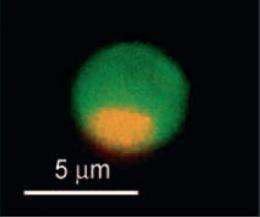Janus particles: particles with two faces

(PhysOrg.com) -- Researchers at the MESA+ Institute for Nanotechnology at the University of Twente, The Netherlands, have devised a method for fabricating Janus particles, so called because, like the Roman god Janus, they have two faces. The research is to be published in the leading trade journal, Angewandte Chemie.
Janus particles are named after the Roman god Janus, who had two faces. The particles are asymmetrical and contain different chemical groups on their various surfaces. From a chemical point of view, it is not easy to make particles of this kind, as the chemical groups in a solution have a tendency to spread uniformly across a surface, rather than settle conveniently on one half of the particle.
Researchers at the MESA+ Institute for Nanotechnology at the University of Twente have devised a method for making Janus particles, by which it is now possible to determine the size of the two 'faces' as well as their appearance.
Masking/unmasking
The University of Twente researchers call their method the 'masking/unmasking method'. In their experiments, they use tiny glass globules of around five micrometres in diameter (one micrometre is one thousandth of a millimetre), over which they apply a layer of plastic that covers them completely. They then etch away the upper layer of plastic thereby exposing the top of the globule while the lower part remains encased in the plastic. This makes it possible to chemically modify the upper part of the globules (and therefore form the first of the faces). According to Professor Jurriaan Huskens, one of the researchers, almost every chemical group can in principle be attached to the globules, including proteins, colouring agents, and artificial receptors.

Next, the rest of the plastic is dissolved, so that the remainder of the surface of the globule is exposed. Attaching a different chemical group to this part results in the creation of a second face on the particles.
The method is suitable for making all kinds of Janus particles, because the researchers can choose the material and size of the globules and decide what chemical groups to attach to them. In addition, they can determine very precisely which part of the plastic layer they etch away and this allows them to decide exactly how large the two faces are.
Given that the method provides chemists with the means of devising a whole range of new particles, all kinds of application fields have now been opened. One such application, believes Professor Huskens, is in the area of medical diagnostics, where Janus particles to which colouring agents have been attached can be used to make specific parts of cells visible.
More information: The article entitled, 'Janus Particles with Controllable Patchiness and Their Chemical Functionalization and Supramolecular Assembly' by Xing Yi Ling, In Yee Phang, Canet Acikgoz, M. Deniz Yilmaz, Mark A. Hempenius, Julius Vancso and Jurriaan Huskens, will shortly be published in the leading journal, 'Angewandte Chemie'.
Provided by University of Twente (news : web)


















